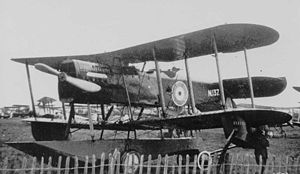Parnall Puffin
| Puffin | |
|---|---|
 |
|
| Role | Fighter reconnaissance aircraft |
| National origin | United Kingdom |
| Manufacturer | George Parnall and Company |
| Designer | Harold Bolas |
| First flight | 19 November 1920 |
| Number built | 3 |
The Parnall Puffin was an experimental amphibious fighter-reconnaissance biplane produced in the United Kingdom just after World War I. It had several unusual features, principally a single central float and an inverted vertical stabilizer and rudder, and showed promise, but at that time no new aircraft were being ordered in numbers for the RAF and only the three Puffins of the initial order were built.
The Parnall Puffin was a two-seat fighter-reconnaissance aircraft built just after World War I. Like the Fairey Pintail, it was designed to meet RAF Specification XXI, issued in May 1919 for an experimental amphibious aircraft that could operate from land, carrier decks or the sea. In many regards, the Puffin was a conventional single-engined biplane of its day, but it had two unusual features: a single, central float (the first British aircraft with this seaplane configuration) and a vertical stabilizer and rudder mounted below the fuselage. The under-mounted vertical stabilizer and rudder, intended to maximise the gunner's field of fire, was also used on the Pintail, and earlier by the Hansa-Brandenburg seaplanes. In the days of tailskid undercarriages for landplanes, such a layout could only be used by seaplanes with floats long enough to sit on the water almost in flying position with the tail well clear of the surface.
The Puffin was a two-bay biplane, its parallel chord, equal span wings having stagger but no sweep; they could be folded for storage. Both upper and lower wings had ailerons. The interplane gap (the distance between the upper and lower wings) was large and the fuselage was mounted high in it, with its top just below the upper wing and its bottom well above the lower one. The fuselage was built up on the standard four longerons, making it flat sided and bottomed, but the top surface had the usual rounded decking. Aft, the lower longerons curved upwards, decreasing the fuselage depth. The tailplane was fixed to the upper longerons and carried a single elevator surface, mounted on off-set hinges to provide aerodynamic balance. The long chord vertical stabilizer and its unbalanced rudder, with a rounded trailing edge would have looked completely at home on top of the fuselage; fitted underneath, its appearance was perhaps more startling than the arrangement on the Pintail, where the rudder was low topped but fuselage mounted, and the vertical stabilizer very cropped.
...
Wikipedia
